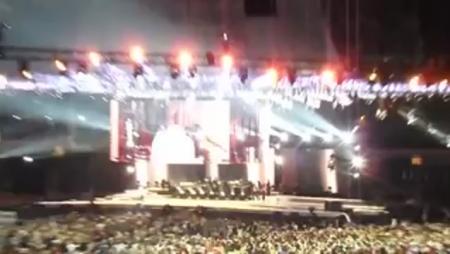Saudis watch a TV broadcast on the death of Crown Prince Sultan bin Abdul-Aziz Al Saud, in Riyadh, Saudi Arabia, Saturday, Oct. 22, 2011. Prince Sultan died abroad Saturday after an illness, state TV said. Sultan, who was the kingdom's deputy prime minister and the minister of defense and aviation, has had a string of health issues. He underwent surgery in New York in February 2009 for an undisclosed illness and spent nearly a year abroad recuperating in the United States and at a palace in Agadir, Morocco. (AP Photo/Hassan Ammar)
Saudis watch a TV broadcast on the death of Crown Prince Sultan bin Abdul-Aziz Al Saud, in Riyadh, Saudi Arabia, Saturday, Oct. 22, 2011. Prince Sultan died abroad Saturday after an illness, state TV said. Sultan, who was the kingdom's deputy prime minister and the minister of defense and aviation, has had a string of health issues. He underwent surgery in New York in February 2009 for an undisclosed illness and spent nearly a year abroad recuperating in the United States and at a palace in Agadir, Morocco. (AP Photo/Hassan Ammar)
File - In this Sunday, Nov. 16, 2008 file photo, Saudi Arabia's Crow Prince Sultan bin Abdel Aziz arrives at the awards ceremony of the Prince Sultan bin Abdul Aziz al-Saud International Prize at King Fahd Cultural center in Riyadh, Saudi Arabia. Saudi TV said Saturday morning Oct. 22, 2011 the kingdom's heir to the throne has died abroad after an illness. He was 85 years old. (AP Photo/Hassan Ammar, File)
FILE - French President Jacques Chirac, right, walks with Saudi Arabia's crown prince Sultan Bin Abdel Aziz, after they signed a defence cooperation agreement at the conclusion of the prince's three day visit in France, at the Elysee Palace in Paris in this July 21, 2006 file photo. The heir to the Saudi throne, Crown Prince Sultan bin Abdel Aziz, died abroad Saturday Oct. 22, 2011 after an illness, state TV said. He was 85 years old. (APPhoto/Remy de la Mauviniere, File)
FILE - Then U.S. Defense Secretary Caspar Weinberger takes leave of Saudi defense minister Prince Sultan bin Abdel Aziz after a meeting at the Saudi minister's residence in Paris in this May 12, 1983 file photo. The heir to the Saudi throne, Crown Prince Sultan bin Abdel Aziz, died abroad Saturday Oct. 22, 2011 after an illness, state TV said. He was 85 years old. (AP Photo/Cironneau, File)
FILE - Saudi Arabia's crown prince Sultan Bin Abdel Aziz, waves to reporters as he leaves the Elysee Palace after signing a defence cooperation agreement with french President Jacques Chirac, visible at top right, at the conclusion of the prince's three day visit in France, at the Elysee Palace in Paris in this July 21, 2006 file photo. The heir to the Saudi throne, Crown Prince Sultan bin Abdel Aziz, died abroad Saturday Oct. 22, 2011 after an illness, state TV said. He was 85 years old. (AP Photo/Remy de la Mauviniere)
RIYADH, Saudi Arabia (AP) ? Saudi Arabia's ruling monarchy moved into a critical period of realignment Saturday after the death of the heir to the throne opened the way for a new crown prince: most likely a tough-talking interior minister who has led crackdowns on Islamic militants but also has shown favor to ultraconservative traditions such as keeping the ban on women voting.
A state funeral is planned for Tuesday in Riyadh for crown prince Sultan bin Abdul-Aziz Al Saud, who died in New York at the age of 80 after an unspecified illness, the official Saudi Press Agency said.
Now, Saudi rulers are expected to move quickly to name the new king-in-waiting ? which royal protocol suggests will be Sultan's half brother, Prince Nayef.
Moving Nayef to the top of the succession ladder would not likely pose any risks to Saudi Arabia's pro-Western policies and, in particular, its close alliance with Washington. But Nayef cuts a much more mercurial figure than Saudi's current leader, the ailing King Abdullah, who has nudged ahead with reforms such as promising women voting rights in 2015 despite rumblings from the country's powerful religious establishment.
Nayef, 78, has earned U.S. praise for unleashing the internal security forces against suspected Islamic extremist cells in Saudi Arabia, which was home to 15 of 19 of the Sept. 11 hijackers. Yet he brought blistering rebukes in the West for a 2002 interview that quoted him as saying that "Zionists" ? a reference to Jews ? benefited from the 9-11 attacks because it turned world opinion against Islam and Arabs.
Nayef also has expressed displeasure at some of Abdullah's moves for more openness, saying in 2009 that he saw no need for women to vote or participate in politics. It's a view shared by many Saudi clerics, who follow a strict brand of Islam known as Wahhabism. Their support gives the Saudi monarchy the legitimacy to rule over a nation holding Islam's holiest sites.
"Nayef is more religious, and is closer to the Saudi groups who are very critical of the king's decisions regarding women and other steps he's taken to balance out the rigid religious practices in society," said Ali Fakhro, a political analyst and commentator in Bahrain.
But it remains doubtful that Nayef ? if ever made king ? would outright annul Abdullah's reforms, which include the establishment of a coed university where both genders can mix. More likely, Nayef would put any further changes on hold, said Abdulkhaleq Abdulla, a political affairs professor at Emirates University.
"It's not good news for Saudis or for the region," he said. "(Nayef) is the security guy. He is the mukhabarat (secret police) guy. He is the internal affairs guy."
Although it's not certain that Nayef will be selected to succeed Sultan, the signs point clearly in that direction.
After Sultan fell ill two years ago, Nayef was named second deputy prime minister, traditionally the post right behind the crown prince. For the first time, however, the mechanism of picking the next No. 2 in the royal succession is not entirely clear.
Traditionally, the king names his successor. But this time it is possible that Abdullah will put the decision to the Allegiance Council, a 33-member body composed of his brothers and cousins. Abdullah created the council as part of his reforms and gave it a mandate to choose the heir.
Abdullah formed the council in order to modernize the process and give a wider voice. When it was created, it was decided that the council would choose the heir for the first time when Sultan rose to the throne, and his crown prince would need to be named. But it was not specified whether it would be used if Sultan died before the king.
The choice of whether to convene the council now will likely be made by the 87-year-old Abdullah, who is currently recovering from his third operation to treat back problems in less than a year.
"It is with deep sorrow and grief that the Custodian of the Two Holy Mosques King Abdullah mourns the loss of his brother and Crown Prince, His Royal Highness Prince Sultan," the palace said in a statement announcing Sultan's death.
The announcement did not elaborate on his illness. According to a leaked U.S. diplomatic cable from January 2010, Sultan had been receiving treatment for colon cancer since 2009.
Sultan was the kingdom's defense minister in 1990 when U.S. forces deployed in Saudi Arabia to defend it against Iraqi forces that had overrun Kuwait. His son, Prince Khaled, served as the top Arab commander in the 1991 operation Desert Storm, in which U.S.-led troops drove the Iraqis out of Kuwait.
As defense minister, Sultan closed multibillion-dollar deals to establish the modern Saudi armed forces, including land, air, naval and air defense forces. On more than one occasion, the deals implicated several of his sons in corruption scandals ? charges they have denied.
Sultan is survived by 32 children from multiple wives. They include Bandar, the former ambassador to the United States who now heads the National Security Council, and Khaled, Sultan's assistant in the Defense Ministry.
U.S. President Barack Obama called the prince "a valued friend of the United States" in a statement of condolence. "He was a strong supporter of the deep and enduring partnership between our two countries forged almost seven decades ago."
"He will be missed," said U.S. Secretary of State Hillary Clinton during a visit to Tajikistan. "Our relationship with Saudi Arabia is strong and enduring and we will look forward to working with the leadership for many years to come."
Britain's foreign secretary, William Hague, said Sultan served his country with "great dignity and dedication."
Saudi Arabia has been ruled since 1953 by the sons of its founder, King Abdul-Aziz, who had more than 40 sons by multiple wives. Sultan was part of the aging second generation of Abdul-Aziz's sons, including Nayef, the full brother of the late King Fahd, who died in 2005.
While Nayef has taken only minor roles in foreign affairs, he has been outspoken in one of Saudi Arabia's chief regional concerns: ambitions by rival Iran to expand its influence in the Middle East.
Earlier this year, he blamed the Shiite power for encouraging protests among Saudi Arabia's minority Shiites.
Nayef also was involved in the kingdom's decision in March to send military forces into neighboring Bahrain to help crush pro-reform demonstrations led by tiny island nation's majority Shiites against its Sunni rulers ? which Gulf Arab leaders accuse of having ties to Iran.
With Yemen, he has called for Saudi Arabia to take a harder line with embattled President Ali Abdullah Saleh, who was treated in Saudi Arabia after surviving a blast in June and later returned to Yemen.
In August, Nayef accepted undisclosed libel damages from Britain's newspaper The Independent over an article which accused him of ordering police chiefs to shoot and kill unarmed demonstrators in Saudi Arabia.
Nayef has chaired Cabinet meetings in place of Abdullah and Sultan. He also draws considerable prestige from being among the sons of Abdul-Aziz's most prominent wife, known as the Sudeiri Seven. Abdullah's predecessor Fahd also was among the seven.
"Nayef's closer links to the Wahhabi establishment may see a reversal of some recent reforms, especially regarding women," said Christopher Davidson, a lecturer at Britain's Durham University and an expert on Gulf affairs. "But more likely business as usual, I think, with no further major reforms."
___
Murphy reported from Dubai, United Arab Emirates. Associated Press writers Maggie Michael in Cairo and Barbara Surk in Manama, Bahrain, contributed to this report.
Associated PressSource: http://hosted2.ap.org/APDEFAULT/3d281c11a96b4ad082fe88aa0db04305/Article_2011-10-22-ML-Saudi-Obit-Sultan/id-d457f02122a24984a1a0d9e2294c2ab3
st louis weather ron paul 2012 mitt romney newt gingrich columbus dispatch social security increase menagerie








 If you have ever posted a thought or idea on Twitter (follow me while you are there! ? Aepiphanni), you can probably tell from the response that the time taken to create and post the tweet barely made am impact.? Just because you posted it didn?t make it go viral.? Because it was brilliant, thought provoking, extraordinary, even, didn?t make people re-tweet it and discuss it until it trended.? As a matter of fact, if you asked many of your followers if they?d seen it, most would probably say that they had missed it and might be kind enough to look for the next one.
If you have ever posted a thought or idea on Twitter (follow me while you are there! ? Aepiphanni), you can probably tell from the response that the time taken to create and post the tweet barely made am impact.? Just because you posted it didn?t make it go viral.? Because it was brilliant, thought provoking, extraordinary, even, didn?t make people re-tweet it and discuss it until it trended.? As a matter of fact, if you asked many of your followers if they?d seen it, most would probably say that they had missed it and might be kind enough to look for the next one.